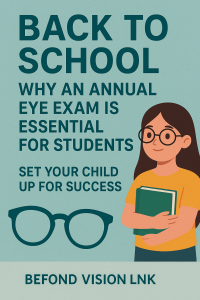
As kids head back to school, parents are busy checking supply lists, buying new clothes, and setting routines. But one important step that often gets overlooked is making sure your child’s eyes are healthy and ready to support their learning. Vision plays a crucial role in the classroom—nearly 80% of learning is visual. If a child can’t see clearly or comfortably, it can affect everything from reading and writing to sports and social confidence.
Eye Screenings vs. Comprehensive Eye Exams
Many parents assume that if their child “passed” a school vision screening or pediatrician’s eye check, their vision is fine. Unfortunately, that’s not always the case. Screenings are quick tests designed to catch only the most obvious problems, like significant nearsightedness. They typically do not assess depth perception, eye coordination, focusing ability, or subtle misalignments.
An eye exam with an optometrist goes much deeper. At Beyond Vision LNK, Dr. Carla Ericksen takes the time to evaluate how well your child’s eyes work together, how efficiently they focus, and whether any hidden issues could be interfering with learning. A comprehensive exam can catch problems that screenings simply miss—helping prevent academic struggles from being mistaken for attention or behavioral issues.
The Overlooked Factor: Binocular Vision Dysfunction (BVD)
One vision condition that often goes undetected in screenings is Binocular Vision Dysfunction (BVD). BVD occurs when the eyes are slightly misaligned, making it hard for them to work together. Even a tiny misalignment can cause symptoms like headaches, eye strain, blurred or double vision, difficulty concentrating, and even dizziness or motion sensitivity.
For students, BVD can make reading exhausting, lead to skipping lines or words, and cause frustration with homework. These children are often bright and capable, but their eyes are working so hard that learning feels much harder than it should. With the right diagnosis and treatment, such as specialized glasses prescribed by Dr. Ericksen, students can experience relief and perform more comfortably and confidently in school.
Why haven’t my doctors mentioned BVD to me?
BVD is a very common condition (impacting at least 20% of all people) yet doctors are rarely diagnosing and treating it. This is because:
1) Inadequate Screening: There has not been a reliable way to quickly screen for BVD and VH, until now (the BVDQ)
2. Inconclusive Testing: Traditional eye exam testing is not sensitive enough to find the small amounts of misalignment that cause symptoms
3. New, Smaller Prism Amounts: Until recently, the amount of prism used to treat the misalignments were too large. It’s the smaller amounts of prism that are needed to provide consistent results.
The NeuroVisual® Evaluation contains tests developed specifically to find the small misalignments, and treats misalignments using very small amounts of prism (microprism).
Set Your Child Up for Success
An annual eye exam is one of the best ways to support your child’s academic success and overall well-being. As you prepare for the new school year, add an eye exam to your checklist—because when kids see better, they learn better.
📅 Schedule your child’s back-to-school eye exam with Dr. Ericksen at Beyond Vision LNK today.
👉 Request an Appointment
If your child struggles with headaches, reading difficulties, or unexplained anxiety, take the next step and learn more about BVD.
🔎 Start with our BVD Questionnaire to see if hidden vision problems could be affecting your child.
